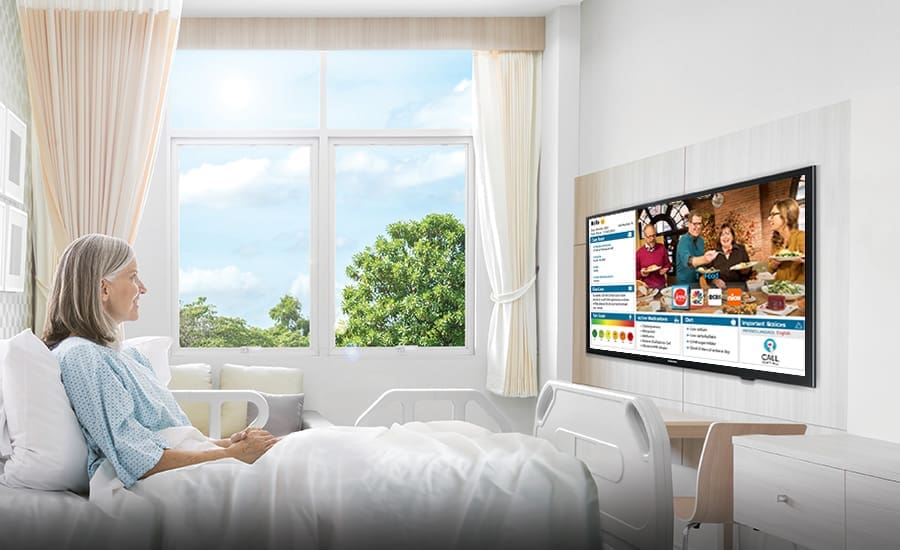The Power of Smart TV Upgrades in Enhancing Patient Experience
A day in the hospital can be long, boring and lonely without someone or something to break the monotony. Perhaps never more so than now.
In a time of visitor limitations in hospitals, the patient room television is about the only option a patient has for entertainment, connection with the outside world, and diversion. As Becker’s Healthcare recently noted, “It’s a way to provide some comfort and pass the time.”
But, what happens if the TV isn’t working right (or at all)? “What if the patient can’t find his or her favorite program because there is no on-screen guide? They’re likely to hit the “nurse call” button. Now, the nurse is addressing a TV issue instead of responding to a healthcare need elsewhere,” the article notes.
In a time when hospital teams are stretched thin, those are interruptions that result in unhappy patients and unhappy nurses.
In the past, upgrading old analog patient room TVs might fall low on a hospital’s budget priorities. But, with increasing demands by patients for a more patient-centered experience, upgrading patient TVs is no longer just a nicety. Here are three ways that upgrading to smart TVs can create happy patients and benefit your hospital.
PATIENTS WANT ENTERTAINMENT – AND MORE
Hospital patients are consumers whose at-home entertainment options are plentiful. Back in our parents’ day, TV viewing consisted of three network channels and rabbit ear antennas. TV is no longer the TV viewing of our parents’ generation. At home, consumers now have nearly limitless options for streaming entertainment, on-demand music and movies, high-quality educational documentaries, interactive games, thousands of TV channels, and digital communication – all enabled by smart devices. Why are so many hospitals so far behind the curve in meeting patient expectations for improved TV entertainment and interactive features?
Those are the expectations patients bring to their hospital stay. Today’s consumer-patients want a home-like, engaging, high-quality, user-controlled entertainment experience while in the hospital. Old-school analog TVs just don’t meet patient satisfaction.
“Patients are seeking improved entertainment options, enhanced patient education, and digital interaction with hospital systems and staff,” says Robert Jensen, vice president of experience & outcomes with Sentrics.
To achieve that requires upgrading old hospital TV systems to smart TV. Smart TVs with interactive features turn a dated, aging hardware into a robust patient experience tool. Those interactive features deliver not only state-of-the-art television programming, but they also create a central hub for a wide range of entertainment and education.
What if your patients, from a single portal on the smart TV, could also access movies, internet, games, in-bed exercise videos, room dining menus, housekeeping requests, room temperature controls, relaxing music therapy and ambient sound videos, patient health records and education?
The upside is happier patients, and the proof is in HCAHPS ratings. As Becker’s noted, “A quality TV experience can help create a happier patient, which will not only lead to higher satisfaction scores but also frees up caregivers to focus on more urgent requests.”
Hospitals using interactive features on the Sentrics platform far exceed their peer groups in improving HCAHPS across the board. For example, patient recommendations skyrocketed 5.63% for hospitals using Sentrics interactive solutions from 2012-2018. For that same period, other hospitals only improved 1.41% on average.
TURN ENTERTAINMENT HARDWARE INTO EDUCATION PORTAL
On average, hospital patients have their patient room television on from 11 to 13 hours every day they are in the hospital. That is according to Samsung, with whom Sentrics has partnered for years to deploy smart TVs in hospitals across the US.
What better opportunity to communicate and interact with the patient than on the device they are watching all day and night?
“Healthcare TVs have the potential to enhance the in-room entertainment experience by integrating EHR information to serve up relevant content related to procedures and recovery,” says David C. Rhew, M.D., Samsung’s chief medical officer. “The technology also tracks patients’ engagement rates so they can be prompted to view more information as needed.”
Torrance Memorial Medical Center has seen the impact of using the TV as an educational portal first hand. The hospital wanted to improve diabetes education. The technology team quickly saw the answer. “We realized we could leverage the existing infrastructure that we have at the hospital with our patient room televisions,” said Ashwin Rohra, Torrance’s manager, interoperability and development.
Using those TVs and the Sentrics E3 interactive patient engagement solution, Rohra said, “We could send patient education videos directly into the patients’ room so that they could look at them at their leisure. They are sent automatically based on the point of care glucose order.”
Videos are assigned directly through the patient’s electronic medical record. In addition, the percentage of those videos a patient has watched is automatically documented in the patient’s electronic medical record.
The seamless approach – with no extra work for the nurse or the patient – has dramatically impacted diabetes education in just two years. “I knew we would see an increase, but to see the viewership go up 600 percent is pretty amazing,” said Shanna Hall, RN, vice president of nursing for Torrance.
GET OUT OF THE TV MAINTENANCE BUSINESS
There’s an operational upside to smart TVs upgrades as well. When a TV isn’t working right, or at all, that does not make for a happy patient. And constant TV maintenance calls are not an efficient use of the facilities staff.
San Antonio’s 217-bed Methodist Hospital | Specialty and Transplant is a bustling medical center, logging nearly 41,000 total patient stays in 2019. Utilizing older analog TVs in many patient areas, the hospital’s two-person building tech maintenance team was often fielding up to 90 TV-related trouble calls in patient rooms monthly.
Since the hospital’s upgrade to smart TVs, the hospital has reduced its TV maintenance issues by an incredible 82 percent. The hospital’s maintenance staff is also seeing an impressive impact on their productivity. Their time spent troubleshooting TV issues in patient rooms has been reduced by 75%.
And, nurses can get back to patient care. “Nursing staff members were spending up to 10-15 minutes in the patient room explaining how to use the TV system. Now we are able to use that time for patient care,” said Deborah Nichols, MSN, BSN, RN, the hospital’s 5th–floor nurse director. “Our patients like the new system’s menu design and iconography, and they find it easy to use.”
A COST-EFFECTIVE PATH TO HAPPY PATIENTS
TV upgrades are one of the most cost-effective ways to improve patient experience in the patient room. Now more than ever, with restricted visitation policies and patient isolation, the patient room TV is a critical lifeline to the outside world and a source of engaging entertainment.
Learn how to improve the patient experience by upgrading your patient TVs.



